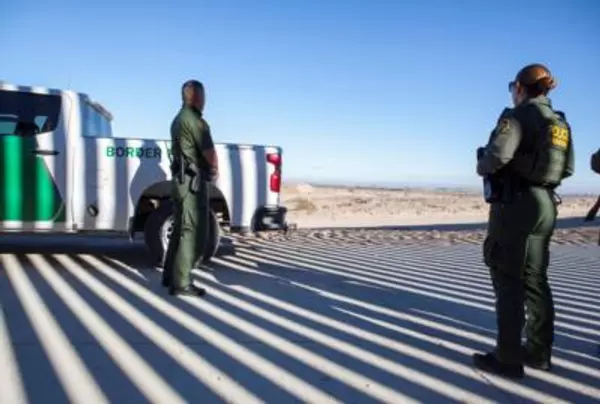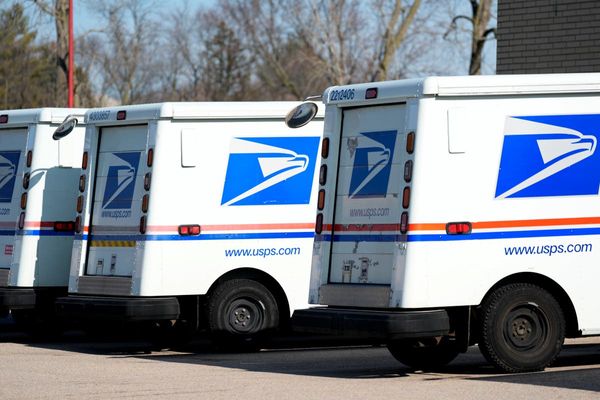
When people die, our whole body dies with us. The heart stops pumping; the gut stops digesting; every cell that carries a person’s genetic blueprint eventually extinguishes, until their molecular signature is extinct. This is the curse of humans’—really, most animals’—multicellular makeup: The cells within our bodies are so specialized, so interdependent, that their fates are lashed together even in death.
Multicellularity does not have to manifest this way, however. Just a hop, skip, and a jump over from us on the tree of life are the choanoflagellates—little marine and freshwater creatures roughly the size of yeast. Choanoflagellates commonly appear as single cells with a long, whipping tail, a bulbous head, and a frilly collar, resembling, as my colleague Ed Yong has memorably described it, “a sperm wearing a skirt.” But under the right conditions, choanoflagellates can also bloom into many-celled bodies, joining individual cells together into single entities that, with some squinting and imagination, bear curious resemblances to the bodies of animals. Their bodies, like ours, are usually genetically identical all the way through; their bodies, like ours, can bend and flex, as if composed of muscles in motion. Their bodies, like ours, can even harbor tiny communities of bacteria that may help them survive.
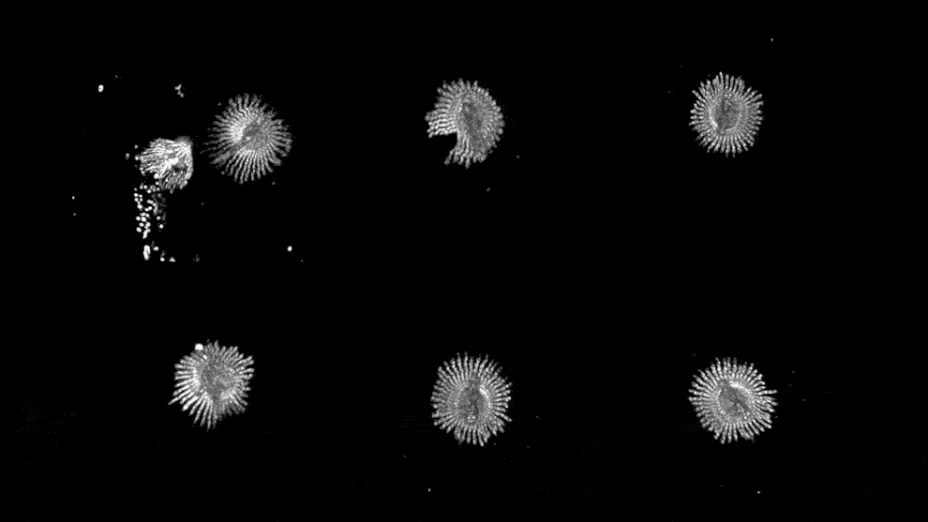
When blown apart or sliced, though, choanoflagellate bodies don’t bleed or collapse into fleshy bits, like ours do. They disaggregate back into single cells, each now free to wander away from its former compatriots and go off on its own. There’s no theoretical limit to this resiliency, experts told me: Were a predator to consume 99 percent of a choano coalition, whatever single cells remained could persist—the rough equivalent of a single human finger, left over from an explosion, crawling away to start existence anew.
In a single lifetime, a choanoflagellate can “completely change its way of interacting with the environment, in truly fundamental ways,” says Nicole King, a choanoflagellate biologist at UC Berkeley. It can shift its means of being in this world. This flexible form of multicellularity isn’t one that the animal lineage kept, but its existence could reveal a lot about our origins all the same. The study of these little creatures has helped reshape how humans conceive of complex bodies, even what it means to be an individual—a notion that gets challenged every time a cell successfully separates itself from the body it once belonged to.
For any creature that can pull it off, managing multicellularity comes with obvious perks. Bigger bodies move more rapidly, use nutrients more efficiently, and more easily resist life’s stressors; they’re harder for predators to swallow and better at chasing down prey. In the course of evolution, multicellularity has proved to be such a boon that it’s thought to have arisen up to 25 separate times—maybe more—in the past 800 million years or so, begetting today’s fauna, flora, fungi, and more in all their wild and wondrous forms. But the modern members of the animal lineage—millions and millions of species of them that flit and fly and sprint and swim and wriggle and crawl—can all trace their origins to a singular uni-to-multi switch. “Everyone agrees that multicellularity in animals evolved once,” says Pawel Burkhardt, a neurobiologist at the University of Bergen, in Norway.
[Read: A 558-million-year-old mystery has been solved]
Just how our ancestors pulled this off, however, remains a big mystery. Choanoflagellates offer a crucial clue. The creatures are widely considered to be the closest living unicellular relatives of animals: a sister twig on the tree of life that grew up alongside ours. That positioning makes choanoflagellates one of the best modern glimpses of the branch from which the animal lineage once sprang, says Flora Rutaganira, a biologist at Stanford University.
More than 100 species of choanoflagellates have been identified so far by scientists. As far as experts can tell, the creatures are quite content to remain on their own in many circumstances. In their default unicellular state, they spend their days swimming and grazing on bacteria; when it’s time to make more of themselves, single choanos double in size, then split cleanly in two. Sometimes, though, choanos decide that a lonesome life is not enough. Instead of fully separating after division, newborn cells that might have once meandered off stay tethered together. In the species Salpingoeca rosetta, even the cells’ innards may interconnect, a bit like an umbilical cord between parent and child that never gets fully cut.
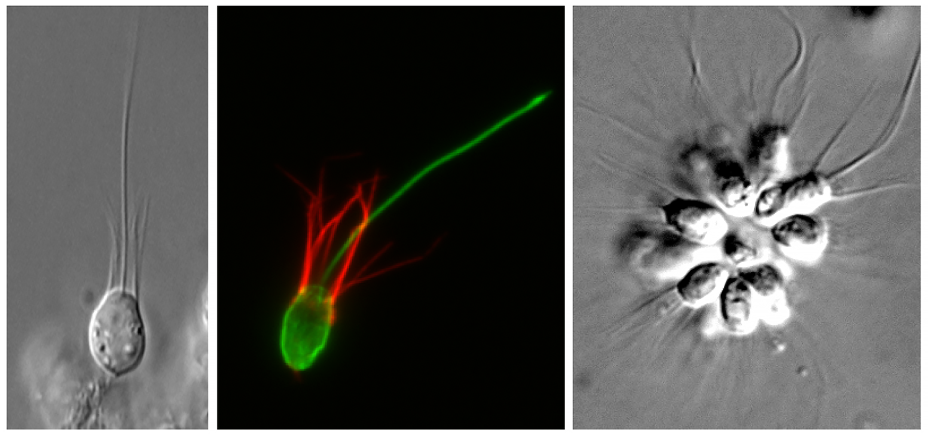
By repeating this process, choanoflagellate colonies can swell to contain dozens, even hundreds, of cells, King told me, and take on a menagerie of shapes. As Thibaut Brunet, a biologist at the Pasteur Institute, in Paris, has found, some, like the acrobatic Choanoeca flexa, can assemble into cup-shaped colonies when exposed to copious light; a plunge into darkness, meanwhile, prompts the groups to invert so that their wiggly ends face out instead of in, a conformation that makes it easier for the coterie to swim. Other species, including S. rosetta, blossom into the lumpy rosettes that give them their name when in the presence of certain types of bacteria. Take a careful gander at some of these orblike colonies, King told me, and they might look a shade familiar: Roughly, thematically, they look almost like animal embryos, ballooning outward into bodies, ready to be born.
Choanoflagellate colonies aren’t really built to last. In the laboratory, scientists can disperse colonies by shaking them or starving them, even squeezing them through a tight space. What was once a body then “just disintegrates” into its cellular components, Burkhardt told me, as if it was never whole. This toggling is an eerie ability, and a powerful one. As great as big bodies can be, they’re also cumbersome, especially when food becomes scarce. Single cells are easier to sate with limited nutrients and reproduce more rapidly; they’re more adaptable to changing conditions, because they don’t have to wait for dozens of their comrades to “come to consensus,” Rutaganira told me. Earth’s mass-extinction events have disproportionately impacted large animals, while sparing the speedy and small, says Pedro Márquez-Zacarías, an evolutionary biologist at the Santa Fe Institute.
Such flexible strategies might be an odd way to think about multicellularity, at least for humans, whose notions hew to the traits of our own bodies: stable, codependent, composed of cells that can survive only if they’re a part of a larger whole. That’s how King first conceived of the concept when she started her lab more than a decade ago. Now, though, “I’ve seen that multicellularity exists along a continuum,” she told me. Cooperation can manifest in a multitude of ways, from transient affiliations—cellular small talk—to permanent mutual reliance.
[Read: The search for the world’s simplest animal]
Humans have had their notions of independence challenged before. Super-social creatures such as bees and naked mole rats, for instance, live in such tight-knit familial societies that they can operate only as a collective; animal guts harbor bustling communities of microbes that evolve alongside their hosts. (Coincidentally, or not so coincidentally, certain choanos also seem capable of housing a bespoke microbiome while in colony form, as a team now being led by UC Berkeley’s Alain Garcia de las Bayonas has found.) It is not unusual to turn many into one. But choanos are among the creatures that flip that narrative and interrogate the worlds that exist within us. When in colonies, they are individuals made up of individuals; when they fragment, they turn one into many. Choanoflagellates’ definition of self “can exist at multiple stacking levels, like Russian dolls,” says María Rebolleda-Gómez, a biologist at UC Irvine. As long as natural selection and evolution can act on an entity—a group, a creature, a cell, a gene—there is arguably an individual lurking within.
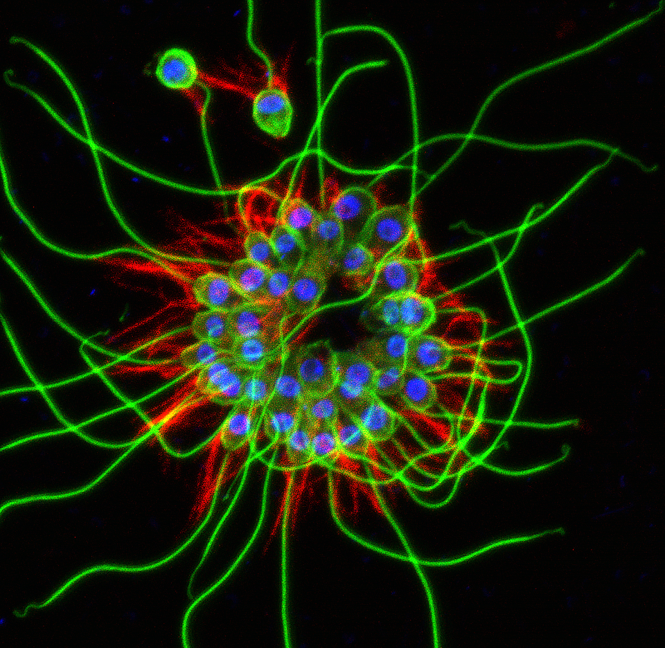
By comparison, humans’ obligate multicellularity may feel strict and suffocating. But we probably shouldn’t be too jealous. A creature that “had a lot of cells that could decide to go off by themselves at any moment would have a lot of problems,” says Iñaki Ruiz-Trillo, a biologist at the Catalan Institution for Research and Advanced Studies, in Spain—a kind of horror movie in the making. That’s sort of what happens with cancer, wherein cells start to mooch off of their colleagues, Márquez-Zacarías told me. It’s microscopic treason, a breaking of the implicit multicellular pact: Individual cells reacquire the kind of autonomy they once lost.
Human multicellularity works best when sustained by countless acts of societal good: the repeated coming together of cells. Each of our cells has made the ultimate sacrifice—of its own independence and, in most cases, the chance to reproduce. But rebellions do occur. Cooperation, even within individuals, hangs by a thread: a truce that, at any moment, can break. Even a once-collaborative choanoflagellate will refuse to go down with its ship.


